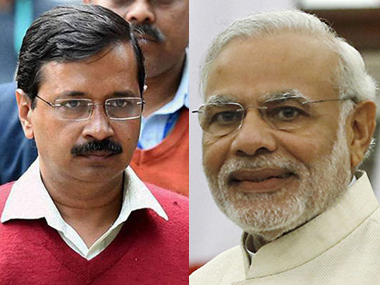Arvind Kejriwal and Narendra Modi have been bitter political adversaries. A closer look though will reveal that they have much in common. A lot has been written about their attacks on each other. However, it will be interesting to explore their myriad similarities. They are the first two national-level politicians of an urbanised (or hoping to urbanise) India. It is no wonder that Kejriwal has built his political career in Delhi, a city-state and Modi in Gujarat, one of the most urbanised and industrialised states in the country. In the recent Assembly elections in Gujarat, where a defeat seemed almost certain for the BJP, Modi retained the state after losing to the Congress in villages, but winning in the cities. The Congress, in the context of the 21st Century, is a relic of our feudal past. It has most of the Maharajas who are led by the Yuvraj. In the past three to four decades, most of the pillars of the feudal citadels in our society have weakened. Caste hierarchies have been seriously challenged. Joint families are fast disappearing thus giving more space to women and younger population to assert themselves. The Congress that was led by local notables, suddenly became irrelevant in many parts of our rapidly changing society because notables lost their stranglehold on society and politics. The decline of the Congress was imminent because of historical reasons, expedited by the abdication of its constitutional, moral and political obligations. [caption id=“attachment_4409125” align=“alignleft” width=“380”] File images of Arvind Kejriwal and Narendra Modi. PTI[/caption] BJP is Janus-faced. It has one face that is buried in our ancient past and the other face that has a vision of communally-polarised urban India. Atal Bihari Vajpayee led a BJP that was essentially a Congress with a saffron tinge and thus, after its rapid growth in the last two decades of the last millennium, it reached a plateau and it joined Congress in its decline. Then Modi arrived on the scene. The collapse of the Congress propelled Modi and Kejriwal to the centre stage of national politics. Their rise was contemporaneous. They offered a tantalising vision of future to their constituents. Modi offered a decisive development-oriented government and Kejriwal offered to clean it up. Caste was made irrelevant by Kejriwal in Delhi and Modi transcended it in Bihar-Uttar Pradesh to get impossible numbers (2015 Delhi Assembly election and 2014 General Election respectively). In the urbanised India, caste is losing — to an extent — its importance as the most important tool of social organisation and mobilisation. Kejriwal used this opportunity to do class-based politics, whereas Modi used the most important identity the urbanised citizenry is left with: Religion. Both of them gave their respective parties unprecedented victories and thereafter have worked overtime to finish their parties as institutions or to retain them as merely a subservient tool to their unbounded ambition with no independent existence. They have ensured stultification or exit of saner elements in their parties and seen the rise of Smriti Iranis and Sushil Guptas. BJP had a federal/democratic structure within the party that has been damaged during Modi’s regime. The exuberance of a movement that Aam Admi Party had is gone. Modi-Kejriwal, for the first time in India, made Facebook and Twitter important weapons of political battles when Rahul Gandhi was not even on Twitter. They had army of professionals working as political karyakartas. Both of them understood politics as battle of image/perception and fought hard to win this battle of images. However, now that they have spent a few years in power, it is clear that they understand politics only as battle of images and nothing more. They have been largely working on perception and not much else. This limited understanding of politics has severely limited their potential. Theatre is part of politics. However, Modi and Kejriwal have reduced politics to only theatre because of their obsession with the battle of image and a disregard for real issues. Therefore, we have been subjected to one spectacle after another. However, very soon both of them are going to realise that reality has strange ways of catching up. The decline of the Congress had given them an open arena where they have spent their time scoring one self-goal after another. It is not Modi versus Kejriwal any more. It is Modi versus Modi and Kejriwal versus Kejriwal, and both of them are out there to defeat themselves. They rose together. Are they going to go down together? That is difficult to predict. However, there is little doubt that they do not have solutions to the numerous problems of the people who voted for them. The collapse of the Congress gave us Modi and Kejriwal. Who is going to fill the vacuum that the decline of Modi and Kejrwal is going to produce? Will the Congress rise phoenix-like from the ashes to take us back to the past millennium. Or will a new brand of politics emerge that is in sync with the aspirations of a new India?
Kejriwal and Modi are the first two national-level politicians of an urbanised (or hoping to urbanise) India. It is no wonder the former has built his political career in Delhi, a city-state and the latter in Gujarat, one of the most urbanised and industrialised states in the country.
Advertisement
End of Article


)
)
)
)
)
)
)
)
)



